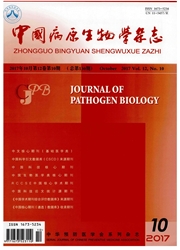

 中文摘要:
中文摘要:
目的 了解恩施和武汉地区手足口病(HFMD)的分子流行病学特征和病原体柯萨奇病毒A16型(CA16)VP1的基因特征。方法 收集2010年4月至2011年8月来自于恩施和武汉地区的189例HFMD患儿咽拭子标本,接种病毒易感Vero细胞,对产生明显细胞病变效应的标本进行初筛和PCR鉴定;对阳性毒株VP1基因序列进行扩增,构建pMD18-T-VP1重组克隆,然后测定其VP1全长序列,通过MEGA5软件构建系统进化树进行系统进化分析,通过DNAstar软件对VP1保守表位的氨基酸序列保守性进行分析。结果 手足口病患者以≤5岁婴幼儿为主,男性多于女性。从189例手足口病患儿咽拭子标本中分离到7株CA16,VP1序列进化分析显示均属于B1亚型。对VP1基因上的6个抗原表位进行分析,其中的3个区域呈现高度保守性,这些保守区可被用于疫苗研究。结论 CA16是2010-2011年恩施和武汉地区手足口病的重要病原体之一,属于B1基因型。
 英文摘要:
英文摘要:
Objectives To evaluate the molecular epidemiological characteristics of hand, foot, and mouth disease (HFMD) and to genetically characterize capsid protein VP1 of CA16 in the Enshi and Wuhan regions. Methods Throat swab samples were collected from 189 patients with HFMD in the Enshi and Wuhan regions between April 2010 and August 2011. Preliminary screening was performed by inoculating the samples into Vero cells to test whether the specimens had a cytopathic effect (CPE). PCR was performed to further identify the pathogens. The VP1 regions of positive samples were amplified, cloned into the vector pMD18-T, and sequenced. Phylogenetic analysis of CA16 strains was per formed with MEGA5, and amino acid sequences of conserved epitopes in VP1 were analyzed with DNAStar. Results Most patients with HFMD were under 5 years old, and more males than females had HFMD. Seven strains of CA16 were isolated from 189 throat swab samples. Phylogenetic analysis of the VP1 sequence revealed that all of the isolated CA16 strains were subtype B1. Six conserved regions in VP1 were examined. Three of those regions were highly conserved, and these regions could be used in further vaccine research. Conclusion CA16 was key pathogen causing HFMD in the En- shi and Wuhan regions and all of the isolated CA16 strains were subtype B1.
 同期刊论文项目
同期刊论文项目
 同项目期刊论文
同项目期刊论文
 Negative life events and corticotropin-releasing-hormone receptor 1 gene in recurrent major depressi
Negative life events and corticotropin-releasing-hormone receptor 1 gene in recurrent major depressi A novel finding for enterovirus virulence from the capsid protein VP1 of EV71 circulating in mainlan
A novel finding for enterovirus virulence from the capsid protein VP1 of EV71 circulating in mainlan 期刊信息
期刊信息
